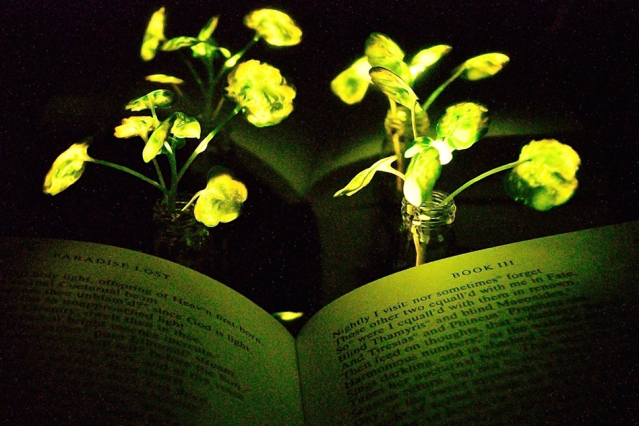https://gadgtecs.com/wp-content/uploads/2017/12/engineers-create-glowing-plants.jpg
Think about that instead of switching on a lamp when it will get dark, you might read by the light of a glowing plant on your table.
MIT engineers have taken a important first step towards making that vision a reality. By embedding specialised nanoparticles into the leaves of a watercress plant, they induced the plants to give off dim light for almost 3 and a half hours. They believe that, with additional optimization, such plants will someday be bright enough to light up a workspace.
“The vision is to make a plant that can function as a desk lamp — a lamp that you don’t need to plug in. The light is ultimately powered by the energy metabolism of the plant itself,” says Michael Strano, the Carbon P. Dubbs Professor of Chemical Engineering at MIT and the senior author of the research.
MIT's postdoc Seon-Yeong Kwak is the lead author of this research, which appears in the journal Nano Letters.
This technology could also be used to supply low-intensity indoor lighting, or to transform trees into self-powered streetlights, the researchers say.
Nanobionic plants
Plant nanobionics, a new research area pioneered by Strano’s lab, aims to give plants novel features by embedding them with various kinds of nanoparticles. The group’s aim is to engineer plants to take over many of the capabilities now carried out by electrical devices. The researchers have previously designed spinach leaves that can detect explosives and communicate that info, as well as crops that can monitor drought conditions.
Lighting, which accounts for about 20% of the worldwide power consumption, appeared like a logical next goal. “Plants can self-repair, they've their very own energy, and they're already adapted to the outdoor environment,” Strano says. “We think that is an concept whose time has come. It is a perfect problem for plant nanobionics.”
To create their glowing plants, the MIT researchers turned to luciferase, the enzyme that provides fireflies their glow. Luciferase acts on a molecule known as luciferin, causing it to emit light. Another molecule known as co-enzyme A helps the process along by removing a reaction byproduct that can inhibit luciferase activity.
The MIT research team packaged each of these 3 components into a different type of nanoparticle carrier. The nanoparticles, that are all made of materials that the U.S. Food and Drug Administration classifies as “generally regarded as safe,” help every part get to the right part of the plant. Additionally they prevent the parts from reaching concentrations that could possibly be poisonous to the plants.
[caption id="attachment_3053" align="aligncenter" width="639"]
 The nanobionic light-emitting plant illuminating a book (two 3.5-week-old watercress plants). The book and the light-emitting watercress plants were placed in front of a reflective paper to increase the influence from the light emitting plants to the book pages.
The nanobionic light-emitting plant illuminating a book (two 3.5-week-old watercress plants). The book and the light-emitting watercress plants were placed in front of a reflective paper to increase the influence from the light emitting plants to the book pages.Image Credit: Seon-Yeong Kwak[/caption]
The researchers used silica nanoparticles about 10 nanometers in diameter to carry luciferase, and they used slightly bigger particles of the polymers PLGA and chitosan to carry luciferin and coenzyme A, respectively. To get the particles into plant leaves, the researchers first suspended the particles in a solution. Plants were immersed in the solution and then exposed to high pressure, permitting the particles to enter the leaves via tiny pores known as stomata.
Particles releasing luciferin and coenzyme A have been designed to build up in the extracellular space of the mesophyll, an inside layer of the leaf, whereas the smaller particles carrying luciferase enter the cells that make up the mesophyll. The PLGA particles slowly release luciferin, which then enters the plant cells, where luciferase performs the chemical reaction that makes luciferin glow.
The researchers’ early efforts at the start of the project yielded plants that would glow for about 45 minutes, which they've since improved to 3.5 hours. The light generated by one 10-centimeter watercress seedling is at present about one-thousandth of the amount needed to read by, however the researchers believe they'll boost the light emitted, in addition to the length of emitted light, by further optimizing the release rates and the concentration of the components.
Plant transformation
Earlier efforts to create light-emitting plants have relied on genetically engineering plants to express the gene for luciferase, however it is a laborious process that yields extremely dim light. Those studies have been carried out on tobacco crops and Arabidopsis thaliana, that are commonly used for plant genetic research. Nevertheless, the method developed by Strano’s lab could possibly be used on any kind of plant. So far, they've demonstrated it with arugula, kale, and spinach, along with watercress.
For future variations of this technology, the researchers hope to develop a method to paint or spray the nanoparticles onto plant leaves, which might make it possible to transform trees and other large plants into light sources.
“Our target is to carry out one treatment when the plant is a seedling or a mature plant, and have it last for the lifetime of the plant,” Strano says. “Our work very seriously opens up the doorway to streetlamps that are nothing but treated trees, and to indirect lighting around houses.”
The researchers have additionally demonstrated that they can turn the light off by adding nanoparticles carrying a luciferase inhibitor. This might enable them to eventually create plants that shut off their light emission in response to environmental conditions such as daylight, the researchers say.
[embed]https://www.youtube.com/watch?v=Wk59zt0ieAg[/embed]
The U.S. Department of Energy funded this research.
https://gadgtecs.com/2017/12/19/engineers-create-plants-that-glow-using-nanoparticles/
Comments
Post a Comment